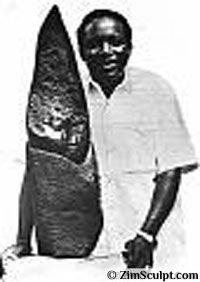Kenyan-born sculptor Joseph Muli has lived in Zimbabwe for the last twenty-nine years. His ebony sculpture conveys the dignity of the people of his own country, and a sense of cultural origin outside of Zimbabwe. However, his personal history and reputation as an artist are strongly linked with the history of Zimbabwean art, and his life has been involved with many events and personalities which have established that history.
Yet, although identifying and being identified with the development of Zimbabwean art, Joseph Muli’s career has differed markedly from that of many Zimbabean artists. There is a Dickensian pathos about his early life. Coming from a poor Kenyan family living outside of Nairobi (his father having three wives and twenty-nine children) he came to Nairobi to find work to support the family. He met and was brought up by an Italian family living in Nairobi. His foster father was an artist involved in the carving of tombstones and their appropriate headstones. His first introduction to art was “angels on tombstones”, and the carving he learned from his foster father was the Italianate carving which gives hard stone its decorative and flamboyant appearance, far removed from its natural properties.
From an early age Muli was encouraged by his foster father to think of art as a career – a career which would be essentially self-directed and not dependent on galleries and mentors. He was able, prior to coming to Zimbabwe, to do many things which Zimbabwean artists rely on galleries to do – to determine and establish the market for his work, to arrange exhibitions and their promotion, and to understand the importance of the correct critical appraisal in establishing standards for an artist’s work. Coming to Zimbabwe after his foster parents’ departure for Italy (his own parents prevented him from going with them), he worked with Canon Edward Paterson at his Nyarutsetso Art School (1964 – 1968) in Harare. The meticulousness, the sense of finish and the attention to detail which characterises his work may have developed during his time with Canon Paterson.
His sculptures today, made from the root of the ebony, are impeccably finished and polished but there is more to them than their outside appearance. At their best they show an understanding of the lonely, the lost and the displaced; perhaps reflecting the artist’s cultural displacement and the personal loss he felt when his foster parents returned to Italy. In these ebony sculptures there is a sense of physical balance as in the balance of works in a carefully fashioned line of verse. His Family, which was in the Zimbabwe Heritage Exhibition of the National Gallery of Zimbabwe in 1989, is carved from one single piece of wood, emphasising the closeness of the family and the unbreakable ties of kinship. Here the material is like the womb, and the children the embryos within it. The length and slender quality of the ebony underpins the plight and physical condition of Fugitive Mother and Child; the curve of the wood the flight of the mother and the child. Within these wooden sculptures there is a sense of preparation of the wood which is almost a veneration of the material, and the fact that nature perhaps tarnishes rather enhances the wood’s appeal.
His Scheming, also in the Zimbabwe Heritage Exhibition of 1989, is one of his few pieces of stone sculpture. Here the two faces carved on the one piece of stone, at times appearing as one face, at times as two, demonstrate the closeness of conspiracy, the need for likeness of mind and spirit for the plot to be worked out, and the secret to be kept. Yet evading the world the “schemers” seem to be avoiding each other’s gaze, perhaps thinking their private thoughts about their mutual resolutions.
Joseph Muli has lived through the history of Zimbabwean art, as an artist, man and observer, as well as a contributor to the welfare of the artists of Zimbabwe. One of the founder members of ZAVACAD – the Zimbabwe Association for Visual Artists, Craftpersons and Designers – he is today its chairman. He works for two days a week as a volunteer in the National Gallery Market, evaluating the work of young artists, marketing it for them, and discussing it with them. When asked to comment he replies: “I want to give to Zimbabwean artists the support my foster parents gave to me, to provide them, through myself and the ZAVACAD executive, with some leadership, in particular for the young artists in the rural areas such as Guruve. ” He comments: “The negative side of the current market forces are, to a degree, cultural manipulation of the younger artists. They say their culture is in their work because their culture is expected to be in their work. A title alone cannot make a statement about culture, the statement must be in the meaning of the work and above all in what it means to the artist! ”
Joseph Muli’s work is possibly an eye witness to the history of the art of Zimbabwe, yet he has on many occasions stepped out of that history to establish the direction of his own career. Whatever role he plays his value to the development of Zimbabwean art is apparent.
JOSEPH MULI (Wakamba, Kenya).
Born: 1944, Machakos, Kenya.
Training: Self taught.
WORKS REPRESENTED in the permanent and overseas collections of the National Gallery of Zimbabwe.
WORKS SELECTED for the Annual Exhibition of the National Gallery of Zimbabwe: 1974-1989.
AWARDS and ACHIEVEMENTS:
1985: Prize, Annual Nedlaw Exhibition, National Gallery of Zimbabwe;
1988: Award of Merit, Zimbabwe Heritage Exhibition, National Gallery of Zimbabwe.
ONE PERSON EXHIBITION: 1974: Standard Chartered Gallery, John Boyne House, Harare.
SELECTED GROUP EXHIBITIONS:
1964: Internal Affairs Exhibition, Rand Easter Show, Johannesburg;
1971: Rhodesian Group Exhibition, Beira, Mozambique;
1975: Contemporary Rhodesian Art, Harare, Zimbabwe;
1975: Nedart Rhodesian Exhibition, Johannesburg.
PUBLIC and PRIVATE COLLECTIONS in which WORKS REPRESENTED:
Private collections inside and outside Zimbabwe.



